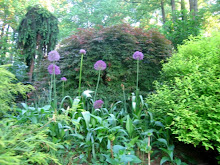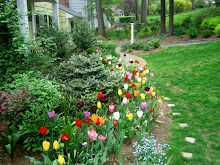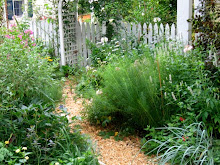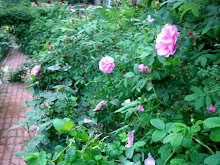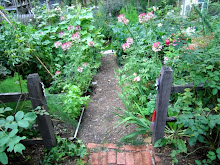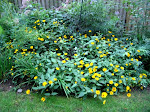Tonight was movie night. The kids wanted to watch Oliver Twist, but I won and we watched Wisley Through the Seasons. Wisley Through the Seasons is about Garden Wisley which is managed by the Royal Horticultural Society:
http://www.rhs.org.uk/WhatsOn/Gardens/wisley/
The movie is beautiful and inspiring, though not instructional. I hope to visit Garden Wisley in person some day, but until then, this is as close as I can get.
Welcome to Heirloom Gardener
Thursday, November 29, 2007
English Gardens: Wisley Through the Seasons
Posted by
Julia Erickson
at
9:21 PM
1 comments
![]()
![]()
Labels: Books and Movies
Cultural Landscape Foundation
Every Thursday, the New York Times has a Home & Garden section, which is usually more home than garden. Today, there is an interesting article on the Cultural Landscape Foundation "which draws attention to historically important natural features and designed landscapes" :
http://www.nytimes.com/2007/11/29/garden/29garden.html?_r=1&ref=garden&oref=slogin
"This year [the Cultural Landscape Foundation] worked with the George Eastman House International Museum of Photography and Film...to commission photographers known for very different kinds of work to record a dozen of the landscapes..." The photo exhibit will start in Rochester, New York, and then travel around the country to "various botanical gardens, museums and historic sites."
For more information on the Cultural Landscape Foundation:
http://www.tclf.org/
For more information on the George Eastman House and the exhibit:
http://www.eastmanhouse.org/
Posted by
Julia Erickson
at
8:27 PM
0
comments
![]()
![]()
Labels: Online Gardening Resources
Wednesday, November 28, 2007
Creating Space for a Garden: the Cutting Garden
Like many suburban gardeners, one of the hardest things to do is find space for all of the plants that you want to cultivate. One solution is to create gardens in the under-utilized parts of your property.
Like many suburban tracts, each home in my neighborhood has about thirty feet of space between each house. When we moved in, the fifteen feet on our side of the property line included a very large rhododendron, some unattractive evergreen trees, some grass, and a lot of weeds. The only thing we did on this strip of property was occasionally walk from the front yard to the back yard.
After a couple of years, we decided to remove the existing trees and plants and transform the space into a cutting garden. This space measures approximately fifteen feet wide and thirty feet long. We created a garden room by installing a wooden picket fence with an attractive arbor and gate in the front (visible in the first picture from inside the garden) and a simple gate in the back. Because the side yard was also on a slope, we installed a short, one-foot dry laid wall in the back to decrease the grade. 
There are three foot beds on either side and a central four foot bed (visible in the second picture). The paths are too narrow at only two feet, but with only fifteen feet to work with, we had to make compromises. The soil was dead, so we dug down about two feet and also created shallow raised beds with ipe wood. Ipe is expensive, but it is far better for your garden than the toxic chemicals in pressure treated wood. Warning: ipe is very hard, which makes it rot and insect resistant, but it also makes it extremely difficult to cut with standard woodworking tools. I had to have my planks cut at the lumber yard. 
After digging out the beds and creating the walls of the raised beds, we then added significant amounts of composted cow manure and Bumper Crop. These are now some of the richest beds on our property.
This is now one of the favorite parts of our property. In addition to changing this from unused and unattractive to a place we visit every day, it also produces abundant cut flowers for indoor enjoyment from May through October.
Related Post: Making the Most of Your Space for Gardening - A Map of My Gardens
Posted by
Julia Erickson
at
10:13 PM
3
comments
![]()
![]()
Labels: Cut and Forced Flowers, Cutting and Rose Gardens, Fences Arbors Walls and Paths, Garden Bloggers' Design Workshop, Garden Planning, Summer Garden
Sophie's Rose Provides Late Season Color
 The frost has come and gone, but Sophie's Rose continues to bloom. I purchased Sophie's Rose on a recommendation from Matterhorn Nursery in Spring Valley, New York, one of the best nurseries in the tri-state area:
The frost has come and gone, but Sophie's Rose continues to bloom. I purchased Sophie's Rose on a recommendation from Matterhorn Nursery in Spring Valley, New York, one of the best nurseries in the tri-state area:
http://www.matterhornnursery.com/
Matterhorn Nursery contains a large David Austin rose display garden and sells many David Austin roses, including Sophie's. It blooms prolifically from May through November.
Sophie's Rose is planted in my front mixed border in part-shade. I am amazed it blooms as much as it does given the lack of full sun.
This is a tall, but not wide rose. It should be planted in a group of at least three, each spaced two feet apart. After being pruned to about twenty-four inches tall in the spring, it ends the season approximately seven feet tall.
For more information about David Austin roses:
http://www.davidaustinroses.com/
Posted by
Julia Erickson
at
8:54 PM
0
comments
![]()
![]()
Labels: Autumn Garden, Cut and Forced Flowers, Front Border, Roses, Summer Garden
Monday, November 26, 2007
The Best Flower Cutting Shears
In all my books about cut flowers, the authors always talk about using high quality shears that are specifically for flowers. Instead, I have been using my kitchen scissors and bypass pruners (Felco #2s) for years. This year, I started using Japanese shears sold as bonsai trimmers available from Takashimaya New York:
http://www.takashimaya-ny.com/
Takashimaya in Tokyo is a large department store like Saks Fifth Avenue. In New York, it is a small multi-level boutique. The top floor is dedicated to cut flowers and accessories. If you appreciate beautiful and hard-to-find cut flowers, it is well worth a visit.
The shears come in three sizes: large for woody flowers, medium for large green stems, and small for delicate stems. They are very sharp and do not damage the stem's ability to take up water. My cut flowers now last so much longer than they ever did before.
Posted by
Julia Erickson
at
10:05 PM
0
comments
![]()
![]()
Labels: Cut and Forced Flowers, Gardening Tools and Structures
Sunday, November 25, 2007
Belinda - Partial Shade Rose
http://www.antiqueroseemporium.com/
Posted by
Julia Erickson
at
9:43 PM
0
comments
![]()
![]()
Labels: Cut and Forced Flowers, Roses, Summer Garden
Ferdinand Pichard - Beautiful Striped Rose
Posted by
Julia Erickson
at
9:43 PM
0
comments
![]()
![]()
Labels: Cut and Forced Flowers, Roses, Summer Garden
Complicata - Vigorous Once Blooming Rose

http://www.antiqueroseemporium.com/
Posted by
Julia Erickson
at
9:42 PM
0
comments
![]()
![]()
Labels: Cut and Forced Flowers, Roses, Summer Garden
Ballerina - All Purpose Repeat-Bloomer
http://www.whiteflowerfarm.com/
Posted by
Julia Erickson
at
9:42 PM
1 comments
![]()
![]()
Labels: Cut and Forced Flowers, Roses, Summer Garden
Veilchenblau - "The Blue Rose"
Posted by
Julia Erickson
at
9:40 PM
0
comments
![]()
![]()
Labels: Cut and Forced Flowers, Roses, Summer Garden
Rose de Rescht - An Intense, Old Rose Fragrance
Posted by
Julia Erickson
at
9:37 PM
0
comments
![]()
![]()
Labels: Cut and Forced Flowers, Roses, Summer Garden
English Gardens: Elements of Organic Gardening by HRH Prince of Wales
I read the following review of Prince Charles's new book in the New York Times:
http://www.nytimes.com/2007/08/23/garden/23highgrove.html?_r=1&oref=slogin
After reading the review, I couldn't wait to get it, as it had already been printed in the UK, but not yet in the US. I pre-ordered it and waited with baited breath. When it finally arrived a few weeks later, I was not disappointed. It was a trove of wonderful information that was applicable to my very own suburban garden. Okay, my less than half an acre doesn't compare to Highgrove, but the Prince does have about one full-time gardener per acre or two. One thing that the Prince can't do organically--even with a royal staff--is keep a proper lawn. Instead, he keeps green spaces that that are mowed. A proper lawn--a monoculture of a specific grass--is just too prone to disease and weeds to manage organically.
The Elements of Organic Gardening
Posted by
Julia Erickson
at
9:09 PM
0
comments
![]()
![]()
Labels: Books and Movies, Pruning and Maintenance
Garden to Vase by Linda Beutler
I purchased Garden to Vase: Growing and using your own cut flowers by Linda Beutler earlier this year. It is the first book on cut flowers that is addressed to the gardener, unlike most flower arranging books that assume you are buying the flowers from a florist. While not all of the information is from first-hand knowledge, it is enough of a start for you to experiment on your own. You can find the book on at:
Garden to Vase: Growing and Using Your Own Cut Flowers
Posted by
Julia Erickson
at
5:57 PM
0
comments
![]()
![]()
Labels: Books and Movies, Cut and Forced Flowers
A Tree Falls Down in New Jersey
Given that I haven't poste since last winter, I guess I only have time for this blog in the off-season.
Last year, the trauma of the garden was a 100+ year-old oak tree falling in the backyard. Our wonderful arborists from Savatree (http://www.savatree.com/) check our trees every year, and both of these trees were quite sound.
Then in the spring, after a heavy rainstorm, we heard a giant cracking sound in the backyard and actually saw the tree falling. This, as the arborist categorized it for insurance purposes, was truly an act of God. As if this wasn't bad enough, it had grown intertwined at the base to a 100+ year-old tulip tree. Removing a tree that has fallen down, assuming that it hasn't fallen down on your house, is a pretty minor job. However, removing a giant tulip tree with no other trees around it, is a major job that requires heavy machinery. The arborists did everything possible to avoid this, but it was unavoidable. The heavy machinery, to say the least, destroyed significant parts of the backyard and garden, not to mention the damage to the driveway. Speakng of insurance, the people at Chubb (http://www.chubb.com/) were wonderful about the whole affair.
The gardening challenge was multi-fold: the back corner of the garden which was formerly full-shade was now full-sun.
To be continued...
Posted by
Julia Erickson
at
5:15 PM
0
comments
![]()
![]()
Labels: Trees
Search Heirloom Gardener
Labels
- About Blogging
- Annuals/Biennials and Perennials
- Autumn Garden
- Books and Movies
- Botanical Gardens
- Bulbs and Tubers
- Children's Garden
- Chrysanthemum
- Clematis
- Container Gardening
- Crocus tommasiniasus roseus
- Cut and Forced Flowers
- Cutting and Rose Gardens
- Dahlias
- Deep Thoughts About Gardening
- Egg Garden
- Fences Arbors Walls and Paths
- Floral arrangements
- Front Border
- Fun Stories About Gardening
- Garden Bloggers' Bloom Day
- Garden Bloggers' Design Workshop
- Garden Planning
- Gardening Blogs
- Gardening Tools and Structures
- Gardening with Children
- Goldberry Hill
- Heirloom and Organic Food
- Hibiscus
- Holidays
- Hydrangeas
- Japanese Beautyberry
- Lilies
- Mixed Borders
- New Jersey / Local Interest
- Nurseries
- Online Gardening Resources
- Peonies
- Pest Control
- Picture This Photo Contest
- Piet Oudolf
- Poppies
- Propagation and Seeds
- Pruning and Maintenance
- Roses
- Seed Heads
- Self Seeders
- Shrubs
- Spring Garden
- Summer Garden
- Trees
- Wildlife in the Garden
- Winter Garden
- Zinia
Blog Archive
-
▼
2007
(48)
-
▼
November
(14)
- English Gardens: Wisley Through the Seasons
- Cultural Landscape Foundation
- Creating Space for a Garden: the Cutting Garden
- Sophie's Rose Provides Late Season Color
- The Best Flower Cutting Shears
- Belinda - Partial Shade Rose
- Ferdinand Pichard - Beautiful Striped Rose
- Complicata - Vigorous Once Blooming Rose
- Ballerina - All Purpose Repeat-Bloomer
- Veilchenblau - "The Blue Rose"
- Rose de Rescht - An Intense, Old Rose Fragrance
- English Gardens: Elements of Organic Gardening by...
- Garden to Vase by Linda Beutler
- A Tree Falls Down in New Jersey
-
▼
November
(14)
















